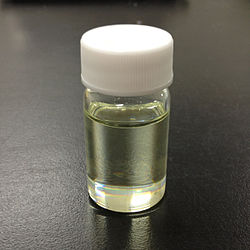
Back Titaan(IV)chloried Afrikaans كلوريد التيتانيوم الرباعي Arabic تتراکولورید تیتانیوم AZB Tetraclorur de titani Catalan Chlorid titaničitý Czech Titan(IV)-chlorid German Cloruro de titanio(IV) Spanish تیتانیم تتراکلرید Persian Titaanitetrakloridi Finnish Tétrachlorure de titane French

| |

| |
| Names | |
|---|---|
| IUPAC name
Titanium(IV) chloride
| |
| Other names
Titanium tetrachloride
Tetrachlorotitanium | |
| Identifiers | |
3D model (JSmol)
|
|
| ChemSpider | |
| ECHA InfoCard | 100.028.584 |
| EC Number |
|
| MeSH | Titanium+tetrachloride |
PubChem CID
|
|
| RTECS number |
|
| UNII | |
| UN number | 1838 |
CompTox Dashboard (EPA)
|
|
| |
| |
| Properties | |
| TiCl4 | |
| Molar mass | 189.679 g/mol |
| Appearance | Colourless liquid |
| Odor | penetrating acid odor |
| Density | 1.726 g/cm3 |
| Melting point | −24.1 °C (−11.4 °F; 249.1 K) |
| Boiling point | 136.4 °C (277.5 °F; 409.5 K) |
| reacts (exothermic hydrolysis)[1] | |
| Solubility | soluble in dichloromethane,[2] toluene,[3] pentane[4] |
| Vapor pressure | 1.3 kPa (20 °C) |
| −54.0·10−6 cm3/mol | |
Refractive index (nD)
|
1.61 (10.5 °C) |
| Viscosity | 827 μPa s |
| Structure | |
| Tetragonal | |
| Tetrahedral | |
| 0 D | |
| Thermochemistry | |
Std molar
entropy (S⦵298) |
355 J·mol−1·K−1[5] |
Std enthalpy of
formation (ΔfH⦵298) |
−763 kJ·mol−1[5] |
| Hazards[6] | |
| Occupational safety and health (OHS/OSH): | |
Main hazards
|
Toxic, corrosive, reacts with water to release HCl |
| GHS labelling: | |
  
| |
| Danger | |
| H314, H317, H330, H335, H370, H372 | |
| P280, P301+P330+P331, P304+P340, P305+P351+P338, P308+P310 | |
| NFPA 704 (fire diamond) | |
| Safety data sheet (SDS) | MSDS |
| Related compounds | |
Other anions
|
Titanium(IV) bromide Titanium(IV) fluoride Titanium(IV) iodide |
Other cations
|
Hafnium(IV) chloride Zirconium(IV) chloride |
Related compounds
|
Titanium(II) chloride Titanium(III) chloride |
Except where otherwise noted, data are given for materials in their standard state (at 25 °C [77 °F], 100 kPa).
| |

Titanium tetrachloride is the inorganic compound with the formula TiCl4. It is an important intermediate in the production of titanium metal and the pigment titanium dioxide. TiCl4 is a volatile liquid. Upon contact with humid air, it forms thick clouds of titanium dioxide (TiO2) and hydrochloric acid, a reaction that was formerly exploited for use in smoke machines. It is sometimes referred to as "tickle" or "tickle 4", as a phonetic representation of the symbols of its molecular formula (TiCl4).[7][8]
- ^ Eremenko, B. V.; Bezuglaya, T. N.; Savitskaya, A. N.; Malysheva, M. L.; Kozlov, I. S.; Bogodist, L. G. (2001). "Stability of Aqueous Dispersions of the Hydrated Titanium Dioxide Prepared by Titanium Tetrachloride Hydrolysis". Colloid Journal. 63 (2): 173–178. doi:10.1023/A:1016673605744. S2CID 93971747.
- ^ "titanium(IV) chloride, 1M soln. in dichloromethane". Alfa Aesar. Retrieved 7 March 2018.
- ^ "Titanium(IV) chloride solution 1.0 M in toluene". Sigma-Aldrich. Retrieved 7 March 2018.
- ^ Butts, Edward H De. "patent US3021349A".
- ^ a b Zumdahl, Steven S. (2009). Chemical Principles (6th ed.). Houghton-Mifflin. p. A23. ISBN 978-0-618-94690-7.
- ^ "Classifications - CL Inventory". echa.europa.eu.
- ^ [1] Archived 2013-02-17 at the Wayback Machine American Chemistry Council – "Titanium Tetrachloride: Stepping Stone to Amazing Technology"
- ^ "Archived copy". Archived from the original on 2014-03-19. Retrieved 2013-04-10.
{{cite web}}: CS1 maint: archived copy as title (link) Iowa State University – "Chemistry Material Safety Data Sheets"
© MMXXIII Rich X Search. We shall prevail. All rights reserved. Rich X Search
